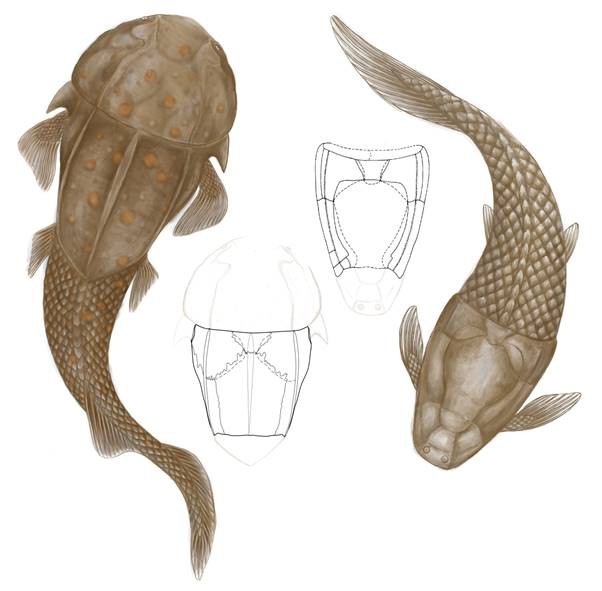When interpreting and restoring incomplete or bizarrely symmetrical animal fossils, the dorsoventrally or even the anteroposterior axis is sometimes reversed. There are many such cases throughout the history of paleontology, such as Elasmosaurus platyurus, the grotesque insect (Hallucigenia) and so on. Recently, Zhu Min, Zhu Youan, and Lu Jing from the Institute of Vertebrate Paleontology and Paleoanthropology of the Chinese Academy of Sciences published their research on a Silurian jawed fish, Z. latifolia, in the journal Royal Society Open Science. The latest research on Silurolepis platydorsalis proves that this specimen has also been reversed in previous descriptions. The broad-backed Silurops, which used to be classified as a platydorsalis, is actually a Silurian platydorsalis unique to my country. , which is of great significance for tracing the earliest evolution of jawed vertebrates.
Fossils of jawed fish from the Silurian period are very rare. In the 1970s, Chinese scholars discovered a rectangular and relatively complete fish carapace fossil in the Silurian strata of Qujing, Yunnan, and named it Silurian broadback. In 2010, Silurian was classified as antiarchs based on its rectangular carapace and two mid-dorsal plates. The carapace is a large group of placoderms and one of the representative fossils of the Devonian "Age of Fishes". Edward D. Cope, who turned the Elasmosaurus fossil upside down, once turned the carapace into a The fish carapace fossils were mistaken for prehistoric aquarium/sea-squirts.html">sea squirts. In order to distinguish them from living aquarium/sea-squirts.html">sea squirts, they were given the name "antiarch", which is still used today.
In the past ten years, a large number of fully preserved early jawed fishes have been discovered in the Silurian strata of Qujing. The discovery of Qilinyu rostrata shows that the early jawed fishes were very diverse in shape, rectangular and multi-piece. The carapace on the mid-dorsal plate is no longer exclusive to carapace fish. This also prompted researchers to re-examine Silurian fossils. After careful observation and further careful repair, the structure of the joint with the head carapace was exposed on the "rear edge" of the Silurian carapace. This means that this is actually the front edge of the carapace. The specimen was separated front and back in past studies. upside down. The revised body armor bone pattern and the morphology of the head and neck joints prove that the Silurian fish fossil is actually a jawed fish that is closely related to the long-snouted Kirin fish and has only been found in the Silurian strata of China. Fish, namely maxillate placoderms, which currently also includes the famous Entelognathus primordialis.
Based on the new discovery of holojawed placoderms, this study clarified the characteristic evolution of exoskeletal head and neck joints in the earliest jawed vertebrates. Most jawed vertebrates have varying degrees of mobility between the head and trunk, but the head-neck joint of the exoskeleton, that is, the joint between the cranial carapace and the trunk carapace/membranous shoulder girdle, is only found in the membranous carapace. Developed early jawed vertebrates. Traditionally, exoskeleton neck joints are divided into major categories such as "sliding joints", "flexion joints" and "reflexion joints". This study is the first to analyze in detail the many independent anatomical characteristics included in these major categories. The results show that the exoskeleton head and neck joints of Silurian holognathic placoderm fishes such as Kirinfish and Silurian fish are embedded with different characteristics of the above categories. It cannot be classified into any of the above categories, and there are no absolute boundaries between these major categories in the past. In fact, they can transform into each other through step-by-step evolution.
Placing these features within the currently popular evolutionary framework of early jawed vertebrates shows that exoskeletal head and neck joints underwent multiple parallel and inverted evolutions, suggesting that as other complex anatomical structures become more studied, including head and neck joints, The distribution of traits within may support different hypotheses for the evolution of the earliest gnathostome systems.
The discovery and detailed study of a series of important early jawed vertebrates in the Silurian and Early Devonian show that the origin of jaws and the earliest evolution of jawed animals is very complex, and there is currently no theoretical framework that can integrate all the conflicting evidence. . Only by continuing to carry out in-depth comparative anatomy studies on more fossil genera and species can it be possible to provide key evidence for the exact shape of the vertebrate evolutionary tree in the earliest stages of gnathostomes.
This research was funded by the Strategic Priority Science and Technology Project of the Chinese Academy of Sciences and the key projects of the National Natural Science Foundation of China.
Paper link: https://royalsocietypublishing.org/doi/10.1098/rsos.191181

Figure 1 Silurian broadback was restored to a carapaceid fish from front to back in the past (right, line drawing from Zhang Guorui et al., 2010). Now based on new evidence, it has been restored to a holognathic placoderm (left, line drawing from Zhang Guorui et al., 2010). Line drawing and restoration drawing). (Painted by Yang Hongyu)

Figure 2 Exploded view and cross-sectional view of the exoskeleton head and neck joints of early jawed vertebrates, showing the characteristic evolution of the exoskeleton head and neck joints. Under the current evolutionary framework of early jawed vertebrate systems, the morphology of the exoskeleton head and neck joints has experienced multiple parallel and reverse evolutions, which means that the evolutionary framework of this system is likely to undergo major changes.
animal tags:
We created this article in conjunction with AI technology, then made sure it was fact-checked and edited by a Animals Top editor.